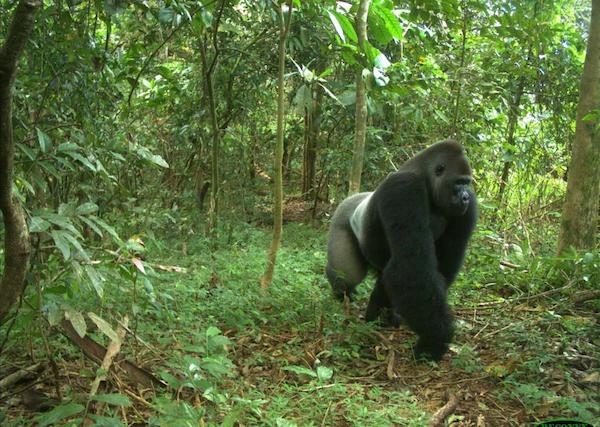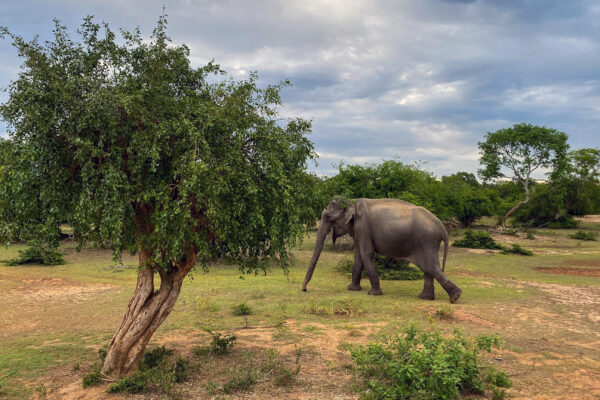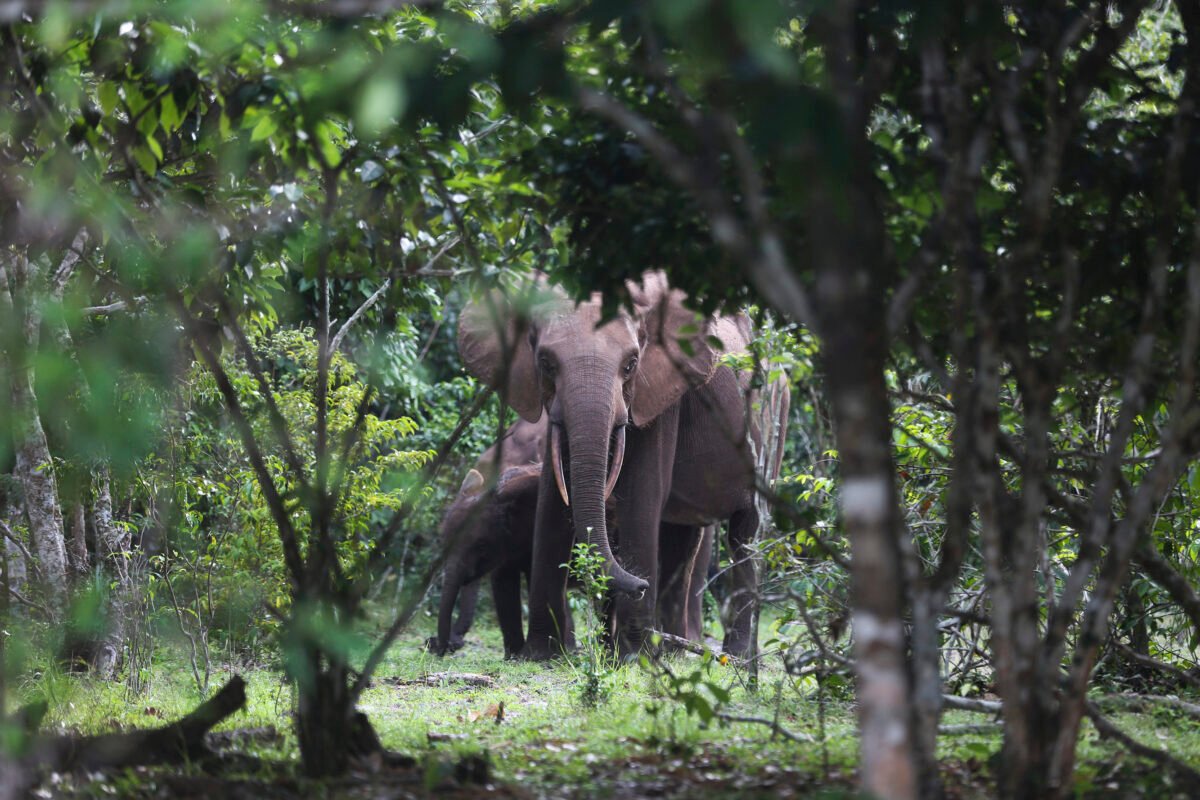Battle Lines Forming in Nigeria as Humans and Animals Compete for Space and Resources
At six o’clock every morning, 55-year-old Sunday Abang rides on a motorcycle from his house in Boki, a farming community in Cross River state in southeast Nigeria.
It takes him at least two hours before he gets to his destination, his cocoa farm, where he spends most of his day carefully cutting down pods and collecting them in baskets.
This usually was his typical day until one Monday morning in March when he arrived at his farm and found his crops damaged by wildlife.
“What I saw made me weak,” he recalled. “The animals destroyed everything in my farm.”

Abang, just like every other farmer in Boki, relies on farming to meet his family’s daily needs and pay for the education of his children. Now that his livelihood has been destroyed, meeting these needs is his greatest concern.
“We don’t have food and some of my children schooling outside [the community] have returned home because there is no money [to pay their fees]. We are dying in silence,” the father-of-11 told The Epoch Times.
Cross River gorilla (Gorilla gorilla diehli) is the most threatened ape in Africa with a population of fewer than 300 surviving individuals.
Cross River state is also home to forest elephants (Loxodonta cyclotis), endangered Nigeria-Cameroon chimpanzee (Pan troglodytes ellioti), drills (Mandrillus leucophaeus), and other primates, forest buffalos (Syncerus caffer nanus), duikers and diverse trees, and birds including the grey-necked rockfowl (Picathartes oreas).
All this is found in Afi Mountain Wildlife Sanctuary, Mbe Mountain Community Sanctuary, and the Okwangwo division of Cross River National Park and protected areas in neighboring Cameroon.
In search of food, these creatures come out of their natural habitats and raid crops cultivated by local farmers. And elephants also destroy farmlands each time they are migrating from the Mbe Mountain to Takamanda Forest Reserve in neighboring Cameroon.
Experts blame this encounter which has resulted in human-wildlife conflict (HWC) primarily on the expansion of farmlands near the protected areas.

The conflict, which occurs mostly in regions where rural communities border protected areas, is when struggles arise from people and animals coming into contact—often leads to people killing animals in self-defense, or as pre-emptive or retaliatory killings, which can drive species to extinction, according to the United Nations Environment Programme (UNEP).
Before now, wildlife’s natural habitats used to be miles away from people’s residences, says Peter Bette, a Boki-based environmentalist.
But things have changed, now that agriculture, which is an important part of rural people’s livelihood, is making people encroach into the natural habitat, plus increasing human population which is exacerbating the situation.
The encounters are increasing as both humans and wildlife compete for space and resources, making the conflict—which is manifested in the loss of crops and lives—inevitable.
“We have moved closer to their habitat because of human activities especially as farms are expanding. Their habitats have been tampered with [and] they are competing with human beings,” Bette, team lead of Biakwan Light Green Initiative, a local NGO promoting primary environmental care about natural resource conservation, told The Epoch Times.
Samuel Odunlami agrees. Odunlami, who is a senior lecturer at University of Port Harcourt’s Department of Forestry and wildlife management, said wildlife need enough space for their daily activities.
“The reality is that human-wildlife conflict is on the rise at the moment, primarily because of [an] increase in human population and humans encroaching into the wildlife habitat.
“We are very close to where they normally get their food. Where they live and go about their natural activities have been reduced,” he explained.
A Global Concern
Globally, conflict-related killing affects more than 75 percent of the world’s wild cat species, as well as many other terrestrial and marine carnivore species such as polar bears and Mediterranean monk seals, and large herbivores such as elephants, according to a report by the WWF and UNEP.
The report, “A Future for All: The Need for Human-Wildlife Coexistence,” notes that HWC is escalating around the world, on land and underwater. One of the direct impacts of this conflict is a loss in annual yields, which in turn affects the income of local farmers.
A 2011 study that assessed the human-wildlife conflict in Filinga Range of Gashaka Gumti National Park (GGNP), Nigeria’s largest reserve, and published by researchers at the Universities of Uyo and Port Harcourt, and GGNP, revealed that out of 853 bags of 50kg crops expected from a planting season, 379 bags were destroyed by primates—mainly tantalus monkeys (Chlorocebus tantalus) and baboons (Papio anubis)—while farmers harvested 474 bags.
This is affecting the investment of farmers especially as they sometimes borrow money to farm.
“So farming is like [an] investment [but] because animals are looking for food, they destroy it. Harvest is always poor so farmers don’t get returns from their investment,” Odunlami told The Epoch Times.
Abang Angela cultivates taro and banana. She is one of those farmers in Boki complaining of poor harvest since the wild animals raided her crops.
Until April last year, she cut bananas from her farm every two weeks to sell. One banana bunch earned 800 Nigerian nairas ($1.74). Sometimes, she cut 18 bunches or more.
“For now, I am at home doing nothing. If I see someone to give me a job, I will accept,” 41-year-old mother-of-two said.
Just like Angela, Abang’s harvest is always bountiful, sometimes up to 30 bags or more with each bag fetching $119.43.
Experts fear the increasing invasion of farmlands by the wildlife will eventually result in retaliation, a major threat to conservation given that the conflict exposes the wildlife, most of which are endangered, to extinction.
This is happening already.

In 2019, 121 people were killed by wild elephants in Sri Lanka. In the same year, 405 elephants were also killed in the country due to HWC.
In Indonesia, 292 crocodiles were killed in 2018 by villagers in the country’s West Papua province. The killings were an act of reprisal for a local farmer killed while harvesting grasses for his cattle in a crocodile sanctuary.
The conflict is also increasing in Africa. Between 1990 and 2007 alone, lions attacked more than 1,000 people in Tanzania—home of the world’s largest lion population—and humans have retaliated at different times.
In 2020, 90 people in Kenya were killed by wild animals and in retaliation, seven elephants were killed by the local community.
Last year, local farmers from Cameroonian border villages killed wildlife from Nigeria’s Gashaka-Gumti National Park, according to a local report. The wildlife was said to cross the Cameroon border to eat farm crops.
In 2018, local hunters killed one elephant said to have invaded the farmlands of residents in Idanre, a community in Nigeria’s Ondo State.
At that time, Ojo Adaralode, the head hunter and president of the hunters association in the area, said the killing of the elephant from the thick forest was “not deliberate but to save the lives and properties of the people living in communities.”
In Boki, where both Abang and Angela are based, Bette said one elephant was killed in 2015. But because of the strong conservation awareness and indigenous by-law that prohibits killing and eating of animals, some of the farmers involved in killing the elephant were ostracized and some people’s properties were destroyed.
But as the demand for space and resources continues to be on the rise, Odunlami believes Boki residents might one day retaliate if there are no measures to enable the people to live harmoniously with the wildlife.
“National parks have laws and regulations so ordinarily, there should be no killings of animals,” he said. “Animals move primarily to look for food and shelter. As they damage crops, the people might retaliate.”
Push for a solution
The WWF-UNEP report acknowledges that it is not possible to completely eradicate human-wildlife conflict. Yet, there are practical solutions that will reduce the conflict and encourage coexistence between humans and wildlife.
Some of these solutions, says Odunlami, include compensation (the payment of financial compensation for livestock or crop losses), fencing (either plant hedges or trenches dug around farmlands), and sensory deterrents (using acoustic noises such as shouting, beating of objects, and gunshot sounds to ward off wildlife).
Odunlami said Nigeria can adopt some of these solutions already working in other countries including Kenya using deterrents such as tape recording of sounds to frighten and keep elephants away from farms.
Put together, Odunlami said, “We are not extending [the] habitat of wildlife, rather we are encroaching in the habitat of wildlife. [So] there should be policies that will set boundaries to how far humans can go [but] we don’t have the policy.”
He adds that “There is a need to also educate the people who are living very close to the habitat and inform them about the consequences of moving close to the habitat.”
Another approach, suggests Bette, is bee farming. “No matter how strong the animals are, when bees surround them, they will run,” he said, adding that “another method is planting of pepper. The odor can chase away animals.”
Both Abang and Angela believe the government plays a critical role in ensuring these solutions are provided. But because the people barely get the government’s attention to conservation issues, they fear solutions might not come their way soon, meaning encounters between humans and wildlife may continue.
“There is no good leader in Cross River state who is giving a helping hand to farmers,” says Abang. He’s making efforts to return to his farm to start all over.
“I have told my [workers] we should go there and start making noise to chase the animals away.”




